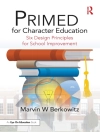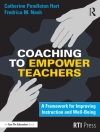‚This book is right on target with its thought-provoking ideas and concepts on the characteristics of successful educational leaders.‘
—Thomas F. Leahy, Consultant, Executive Search Department, Illinois Association of School Boards
‚Our best teachers obtain great results by building positive relationships with their students. Gray and Streshly show how our best principals do the same thing and how these behaviors can be learned and practiced.‘
—Kevin Singer, Superintendent, Topeka Public Schools, KS
Build your capacity to lead your school to greatness!
Great leaders are made, not born. Written by the authors of From Good Schools to Great Schools, this sequel shows how great school leaders can be developed and how leaders can acquire the powerful personal leadership characteristics that the best administrators use to lead their schools to greatness.
Based on sound strategies and the work of Jim Collins, Susan Penny Gray and William A. Streshly tackle how to build relationships, communicate effectively, exercise your personal will with humility, face brutal facts, get faculty on board, and build a school culture of self-discipline. Chapters include:
- Case studies that provide an ongoing context for professional learning
- Self-assessments that reveal your inherent leadership dispositions
- Interviews and tips from exceptional principals in the field
- Strategies for developing specific leadership qualities
- Application exercises that reinforce how to put the strategies into action
- Reflection activities that encourage professional growth
Appropriate for both individual and group professional development, Leading Good Schools to Greatness reveals how leadership skills can be learned and used to take your school to the next level.
Inhaltsverzeichnis
List of Figures and Tables
Foreword by George Manthey
Preface
Acknowledgments
About the Authors
1. The Skills for Leading Good Schools to Greatness Can Be Learned
Applying Good to Great Research to School Principals
Conversations With Highly Successful Principals
Administrator Preparation Program Reform
Reflection
2. First, Build Relationships
Reflection
Assess Your Leadership Capacity
A Behavior Different From That of Effective Private Sector Executives
The Three Key Elements Needed to Build Relationships
Constructing Your Personal Profile of a Highly Effective Principal
Part I: Building Trust
Part II: Engaging in Effective Interpersonal Communication
Part III: Encouraging Constructive Conflict Around Ideas
Ask an Effective Principal
Reflection
3. How to Exercise Your Professional Will With Humility
Reflection
Assess Your Leadership Capacity
Research on the Risks of Charismatic Leadership For Schools
Distinguishing Personal Humility Is Not So Easy
What Highly Successful Principals Say Conveying a Duality of Professional Will and Personal Humility
Strategies for Exhibiting Professional Will While Remaining Humble
Practical Application of Strategies for Exhibiting a Duality of Professional Will and Personal Humility
Ask an Effective Principal
Reflection
4. How to Face the Brutal Facts…Then Do Something about Them
Reflection
Assess Your Leadership Capacity
The Research on Confronting the Brutal Facts and Unwavering Resolve
What Highly Successful Principals Say About Confronting the Brutal Facts
Strategies for Confronting the Brutal Facts and Then Doing Something About Them
Ask an Effective Principal
Reflection
5. How to Get the Right Faculty on Board
Reflection
Assess Your Leadership Capacity
The Research on Getting the Right People
What the Right Place for the Right People Is
The Wrong People for the School
What Highly Successful Principals Say about Getting the Right People
Strategies for Getting (and Keeping) the Right People
Practical Application of Strategies for Getting the Right Faculty on Board
Ask an Effective Principal
Reflection
6. How to Find and Promote the Hedgehog Concept in Your School
Reflection
Educators Differ from CEOs
Assess Your Leadership Capacity
Research on the Hedgehog Concept
Highly Successful Principals Exhibit the Hedgehog Concept
Strategies for Understanding and Executing the Hedgehog Concept in Schools
One School’s Process for Developing New Mission and Vision Statements
Practical Application of Strategies for Finding and Promoting the Hedgehog Concept
Ask an Effective Principal
Reflection
7. How to Build a School-Wide Culture of Self-Discipline
Reflection
Assess Your Leadership Capacity
The Research on a Culture of Self-Discipline
What Highly Successful Principals Do to Build a School-Wide Culture of Self-Discipline
Practical Application of Strategies for Building a Culture of Self-Discipline
Ask an Effective Principal
Reflection
8. The Road Ahead
Research on Leadership Preparation
What to Look for in a Principal Preparation Program
Tips to Help New Principals Succeed
A Final Word
Resource A: Research Methodology
Resource B: Interview Participant Selection
Resource C: Principal Interview Questions Derived From Collins’ (2001) CEO Interview Questions and Demographic Questionnaire
References
Suggested Readings
Index
Über den Autor
William A. Streshly is Emeritus Professor of Educational Leadership in the College of Education at San Diego State University (SDSU). Prior to coming to SDSU in 1990, he spent 25 years in public school administration, including five years as principal of a large suburban high school and 15 years as superintendent of several California school districts varying in size from 2, 500 to 25, 000 students. In addition to his numerous publications in the professional journals, Dr. Streshly is author or co-author of five practical books for school leaders, The Top Ten Myths in Education, Avoiding Legal Hassles (two editions), Teacher Unions and Quality Education, Preventing and Managing Teacher Strikes, and From Good Schools to Great Schools: What Their Principals Do Well.Currently, Professor Streshly is a Senior Lead Auditor for Curriculum Management Systems, Inc., an affiliate of Phi Delta Kappa International. He has audited the instructional operations of more than 40 school districts in 16 states. His intense interest in the role of effective school leadership stems from his own extensive experience as well as his in-depth observation of the work of hundreds of practicing school principals across the country.












